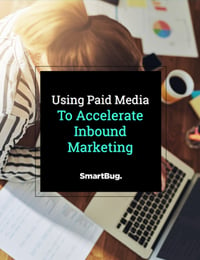
It is not surprising that many of us find pop-ups aggravating. Fun fact: The person who invented pop-up ads in the mid-1990s has publicly apologized.
Pop-up ads are often employed for lead generation, pushing ad content to the forefront of a visitor’s attention. The conventional pop-up—an ad that opens a new window and disrupts your browsing experience—was popular long ago (in internet years), with its popularity surging in the 1990s and 2000s. With this popularity came disdain, as the first browser-based pop-up blockers emerged in the early 2000s.
And yet, all these years later, people are still using pop-ups—though we’ve shifted from the annoying new-window pop-ups to the generally more acceptable hover ad (a.k.a. lightbox ad), which opens on the same site page as the destination content. A lightbox ad opens in the center of the page, obscuring the page content. This kind of ad is frequently employed by news and media sites but has found increased use on corporate websites to highlight content or promotions.
With billions of pop-ups generated every year, the question remains: Do pop-up ads really work?
What Is a Pop-Up ad?
Let’s start with the basics: A pop-up ad is an overlapping window that appears on a web page with a clear, concise call to action (CTA). The style and triggers of pop-ups vary, including those that cover the whole web page upon a user’s exit intent to those that appear in a lower corner after the user has scrolled. Pop-ups that demand attention have a bad rap, but not all pop-ups are intrusive or annoying. In fact, some pop-ups—like live chat indicators—are downright helpful.
What Data Do We Have On Pop-Up Ads?
When you do a quick Google search for data about pop-ups, you may find this article on blocking pop-up ads and posts on forums, question-and-answer sites, and beyond about how to turn off ads.
It seems that no one likes pop-ups. If you’re designing your website primarily for humans, not search engines, then user experience should be your first focus when considering ads of any kind.
How Do Users Feel About Pop-Up Ads?
- Seventy-three percent of internet users automatically disapprove of pop-up ads.
- Ninety-one percent of respondents said ads were more intrusive in 2020 than 2-3 years prior.
- Forty-seven percent of respondents believe “obnoxious or intrusive” ads result in a poor opinion of the websites that allow them.
- And now we need to factor in that most users don’t even see pop-ups anymore. All major web browsers have built-in pop-up blockers.
Users say they don’t like ads, and advertising spend is notoriously difficult to track and tie to sales. That’s it, right? Pop-ups must be out of the picture. Not so fast ...
How Do Users Interact with Pop-Ups?
Here’s where it gets interesting: Despite the above evidence that ads provide a poor user experience, pop-ups can be incredibly effective when implemented appropriately. I don’t mean pop-up advertising like the Wild West internet of 2002, but rather lightbox-style pop-ups that you implement selectively on your website.
Here are the facts:
- Copyblogger found that implementing a pop-up strategy boosted email list opt-ins.
- Pop-ups generally have decent conversion rates, with an average of 11 percent.
- Pop-ups helped BitNinja increase subscriptions by 114 percent and leads by 65 percent.
- Pop-ups helped Entrepreneur increase newsletter subscriptions by 86 percent and sales by 162 percent.
Despite their anti-ad attitude, users often engage with pop-up ads. However, pop-ups aren’t a guarantee for all sites and users. Copyblogger’s Beth Hayden noted that, despite the efficacy of pop-ups, she received hate mail when she implemented her site's pop-up mechanism.
So that begs the question ...
How Should Marketers Effectively Use Pop-Up Ads?
First, remember the foundation of any digital marketing tactics: the user. If you know your user, their habits, and their goals, you can roll out pop-up ads that provide a good experience.
Second, abandon the technical pop-up and embrace the hover or lightbox style of promotion. It provides a better, more consistent experience and shouldn’t annoy people too much because it doesn’t open a new window.
Next, test, test, and test some more. If you decide to go from a pop-up-free to a pop-up-embracing website, you must be prepared to take a risk. Although you might be hesitant to try this strategy, 83 percent of respondents to one HubSpot survey agreed that not all ads are bad.
Whether or not pop-ups are effective depends on your content and personas—what works well for one blog or corporate site may not be successful for another. Avoid pop-ups If you don’t have a way to test and measure results or don’t work in an environment where a failed test is an acceptable risk.
If you're considering a modal or pop-up for your website, you need to ensure that you can hide that pop-up on mobile devices or you risk facing a Google penalty. If you use HubSpot, this responsive feature is built into the lead flows tool.
Pop-Ups That Work on Corporate Sites
Slide-In
These pop-ups are some of the least intrusive styles because they appear after the user has spent time on your site and are relatively small boxes that float in the site’s margins without covering any content. On mobile, they may float at the bottom of the screen, still allowing the user to see most of the site. The timing hover-style pop-up provides an ad without risking an increase in bounce rate.
Premium Content
If you’re promoting a white paper, e-book, or another piece of premium content, a pop-up may be a successful way to draw attention to it, increase conversions, and boost lead generation.
End-of-Page Hover Ads
The problem with certain hover ads is that they load upon opening a page, and users close them immediately because they don’t know anything about the site they landed on. Instead of taking this approach, try using a hover ad when visitors are further down a page—like at the end of a blog post.
Exit-Intent Pop-Ups
In line with end-of-page hover ads, exit-intent pop-ups appear when the user is about to leave the site, usually dependent on when the cursor moves from the page or when the user removes their finger from the screen. The user’s behavior indicates your last chance to interest them, so the best chance of conversion is with a simple call to action and valuable offer.
Gamification
Who doesn’t love a game? Even more, who doesn’t love a deal? Gamified pop-ups use fun graphic elements such as prize wheels, scratch-offs, or multiple-choice quizzes to encourage user interaction. This approach is engaging and can offer a chance to win free shipping, discounts, or products/services in exchange for contact information.
Cart Abandonment
E-commerce companies know a thing or two about cart abandonment and how effective it is to remind shoppers of the items they considered purchasing. A cart abandonment pop-up provides a retargeting approach with a highly personalized experience. You can even feature exit-intent strategies by offering a coupon code to encourage a shopper to finalize their purchase.
Limited-Time Offers or Countdowns
Urgency and novelty are proven to inspire action, and that is precisely what a limited-time offer or countdown can provide in a pop-up. Similar to a gamified pop-up, this one uses graphics to indicate an expiring offer. Some of these have actual countdowns to encourage the user to buy from the site within a few minutes, while others relate to a seasonal promotion.
Creating a Pop-Up Strategy
Knowing pop-up types is only one part of building a pop-up strategy. The content of the pop-ups is just as important as the location and style, so consider the CTAs that best work with the tactic and user behaviors. If your user is on your blog, chances are that they are not as familiar with your brand and might benefit from a premium content offer. Conversely, a user on your product or services page might be ready to hear about your free trial or demo. Similarly, combining an exit-intent pop-up with a limited-time offer redeemable through one button click could be the best recipe for an interaction.
Always Think SMART
If you decide to test pop-up or lightbox ads on your site, always keep SMART goals—goals that are specific, measurable, attainable, relevant, and time-bound—in mind.
Be prepared to test for a predetermined amount of time and evaluate your results before making a permanent decision. When you interrupt the user experience, it is especially crucial to offer relevant, helpful content. With your SMART goals set, you can more easily understand your baseline metrics and see how your new test affects your users.
The right kind of pop-ups can improve website conversions, but implementing a marketing strategy that annoys visitors could end your relationship forever.
Tread lightly. Test often.
This blog was originally written on June 10, 2016 and has been updated since.
About the author
Marissa Litty-McGill was formerly a HubSpot Technologist and Certified HubSpot Trainer with 10+ years of marketing experience spaning both B2B and B2C industries. Though she received her Communications degree in Journalism & PR/Advertising, she fell for marketing before walking across the University of Nebraska at Omaha's graduation stage. You can find her cross-stitching, gaming or exploring the world with her husband and dog when she isn't geeking out over inbound and databases. Read more articles by Marissa Litty-McGill.










